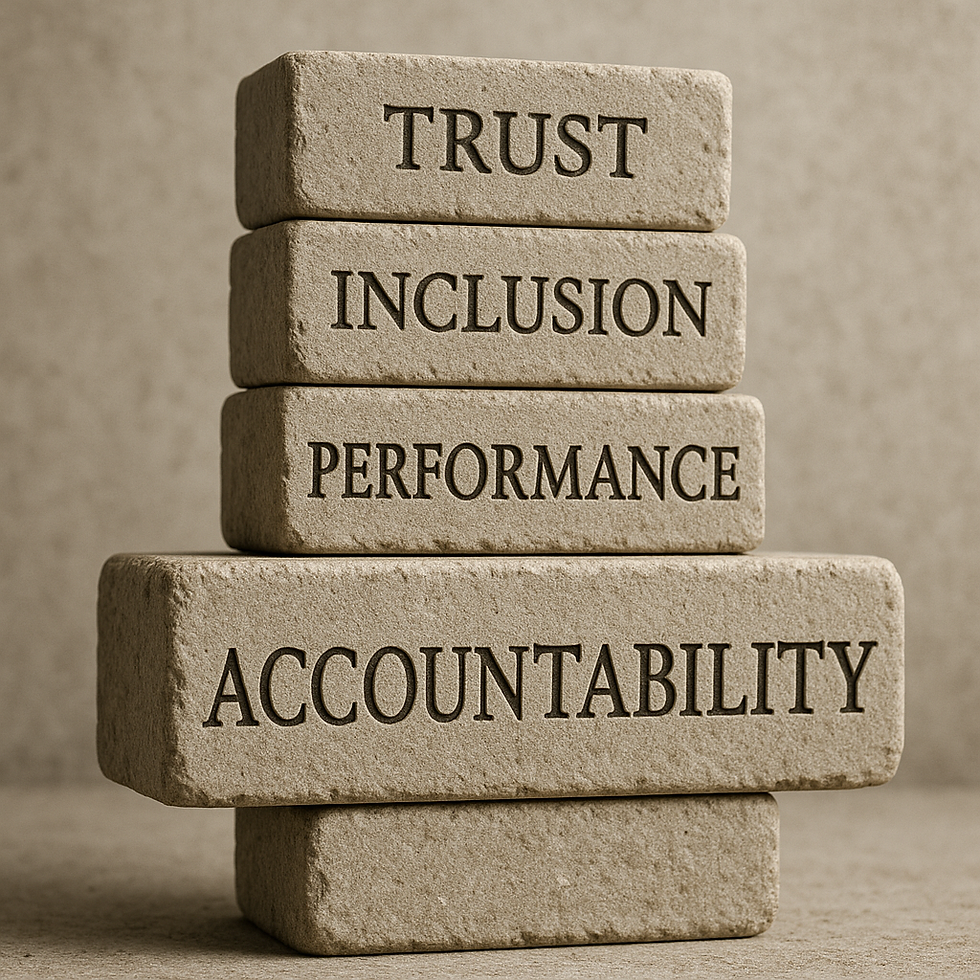The Principles of Personal Leadership: A Path to Transformational Leadership Principle #7: Look in the Mirror First – Be Accountable
- sawolfdo
- Aug 15
- 4 min read
Updated: Sep 13
Inspired by Mark Sasscer’s “Accountability Now!”
Accountability is the Cornerstone

The most impactful leaders begin by looking inward. Before asking others to improve, the most effective leaders examine their own decisions, actions, and the results they produce. This willingness to evaluate oneself is the foundation of transformational leadership.
Accountability in leadership means honoring commitments, taking responsibility for outcomes, and demonstrating integrity even when the outcome is disappointing. Leaders who embrace this mindset create an environment where people feel safe to learn and contribute. By owning both successes and failures, they send a powerful message: transparency matters, mistakes are part of the journey, and growth is always possible.
Mark Sasscer emphasizes that leadership is deeply personal. Titles and positions may open doors, but credibility is built through consistent behavior. When leaders are open about their own shortcomings and the lessons they draw from them, they set the tone for a culture that values honesty and continuous improvement.
Building Trust Through Ownership
When challenges arise, it is easy to point to outside factors. Transformational leaders instead begin by asking themselves hard questions:
What role did I play in this situation?
What could I have done differently?
What am I willing to do now to make it right?
This approach, often called the ownership mindset, is contagious. When leaders model it consistently, they give their teams permission to do the same.
Think about a leader who admits when they’ve made the wrong call, apologizes when their communication misses the mark, and shares lessons learned, not just wins. Far from eroding confidence, this builds it.
I once attended a leadership retreat where a hospital executive opened with a personal story about an initiative they had led that failed to deliver. Rather than shifting responsibility or hiding behind metrics, they spoke candidly about their blind spots and how they planned to approach similar projects in the future. That vulnerability set the tone for the entire retreat. People felt free to share their own challenges without fear of judgment, which led to more honest dialogue and better collaboration.
The Link Between Accountability and Inclusion

Accountability also has a direct connection to inclusion. When leaders model openness about their own mistakes, they create psychological safety for others to say, “I made a mistake.” In this environment, team members are more willing to share concerns, challenge ideas, and offer alternative perspectives when they know they will be respected, even if their input reveals flaws in a plan.
Inclusive cultures thrive when people believe they can take risks, challenge the status quo, and still be valued. Leaders who regularly say, “I don’t have all the answers” or “Help me see what I’m missing” invite others to step forward and share their perspectives. This transforms accountability from a top-down directive into a shared commitment.
Choosing to Lead as an Owner, Not a Bystander
Accountability is ownership not only of your performance, but of your culture, your outcomes, and the ripple effect of your leadership.
True ownership goes beyond achieving perfect results. It involves showing up fully, recognizing the effect of your decisions, and making thoughtful changes when a strategy falls short. Leaders who approach their work this way build credibility because their behavior consistently reflects their values.
Practical Ways to Strengthen Accountability
Leaders can strengthen accountability through deliberate habits. These practices set expectations for themselves and for their teams.
Before offering criticism or coaching, pause to examine your role in the situation. Were your expectations clear? Did you provide the resources and guidance needed for success? Reflecting first ensures that any feedback you give is constructive and fair.
Acknowledge mistakes openly and share lessons learned. When a leader admits a mistake and explains the insight gained from it, they remove the stigma around failure. This makes it easier for others to be transparent about their own challenges, which accelerates collective learning.
Let your peers and team members know that you want them to speak up if they see you falling short on commitments or values. This signals humility and reinforces the idea that accountability works in every direction, not just from the top down.
If you expect high performance from your team, match it in your own follow-through. Meeting deadlines, showing up prepared, and following through on promises demonstrate that you value reliability as much for yourself as for others.
When someone steps forward to take responsibility, acknowledge it, even if the result was less than ideal. Recognition reinforces the behavior you want to see repeated and builds a stronger team culture.
Questions to Ponder
Regular self-reflection keeps accountability from becoming an afterthought. Consider:
How can I take ownership of my actions to inspire accountability and growth in others?
When something doesn’t go as planned, is my instinct to look outward or inward?
When was the last time I publicly acknowledged a mistake and shared what I learned?
Do my team members feel safe admitting when they’ve fallen short?
Where might I be unintentionally modeling avoidance rather than ownership?
What behaviors do I reward—and do they reinforce personal accountability?
The Long-Term Value of Leading with Accountability
Over time, a leader’s example becomes a powerful teaching tool. Teams begin to adopt the same mindset, approaching problems with a focus on solutions instead of blame. This shift improves collaboration, strengthens resilience, and drives sustainable performance.
Accountability is a sustained commitment to integrity, self-awareness, and improvement. Leaders who commit to this path inspire trust and loyalty, laying the groundwork for meaningful and lasting impact.
Final Thoughts
Leadership credibility grows when words and actions align. When you consistently “look in the mirror” before pointing a finger, you model the ownership mindset that fuels trust, inclusion, and high performance. In doing so, you don’t just lead—you lead by example.
Acknowledgment
This series draws inspiration from Mark Sasscer’s Accountability Now! Living the Ten Principles of Personal Leadership. His work continues to influence my thinking and serve as a foundation for those of us committed to leading with clarity and intention.
As always, I welcome your reflections. Feel free to leave a comment or connect with me at scott@drscottwolf.com. I’d love to hear your perspective.




Comments